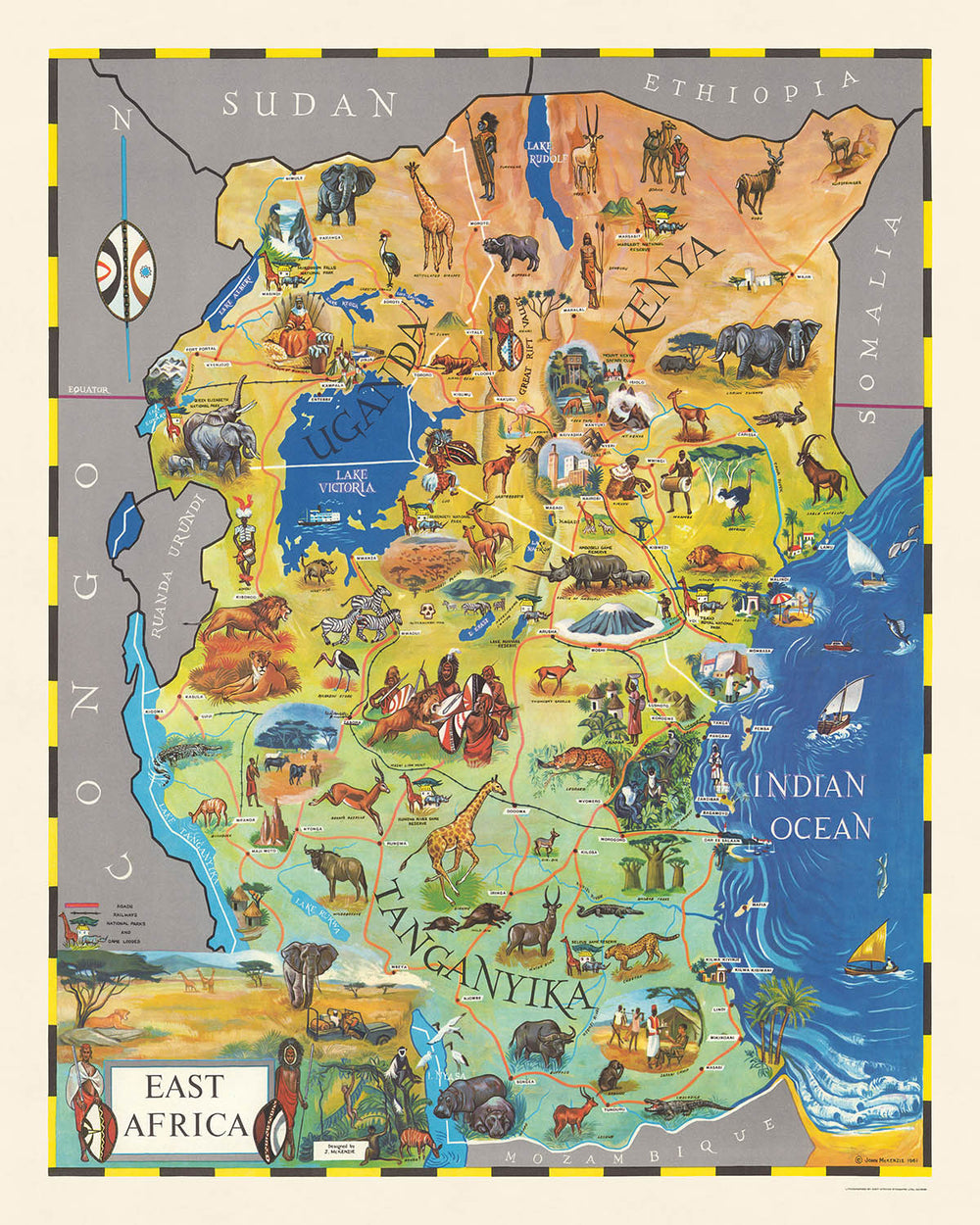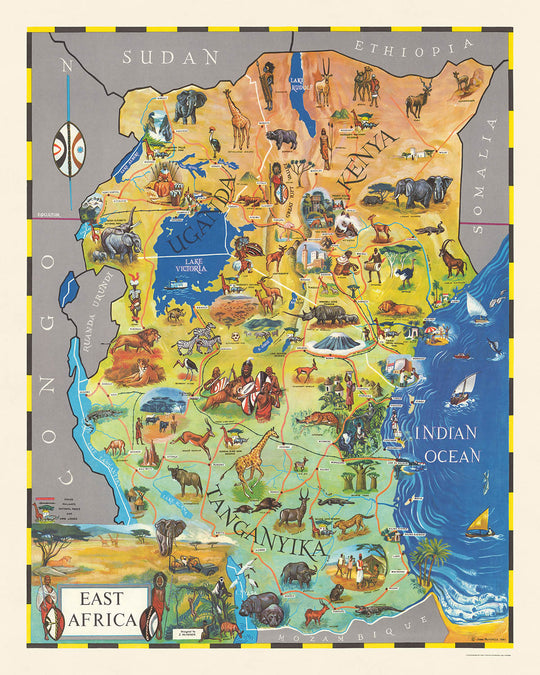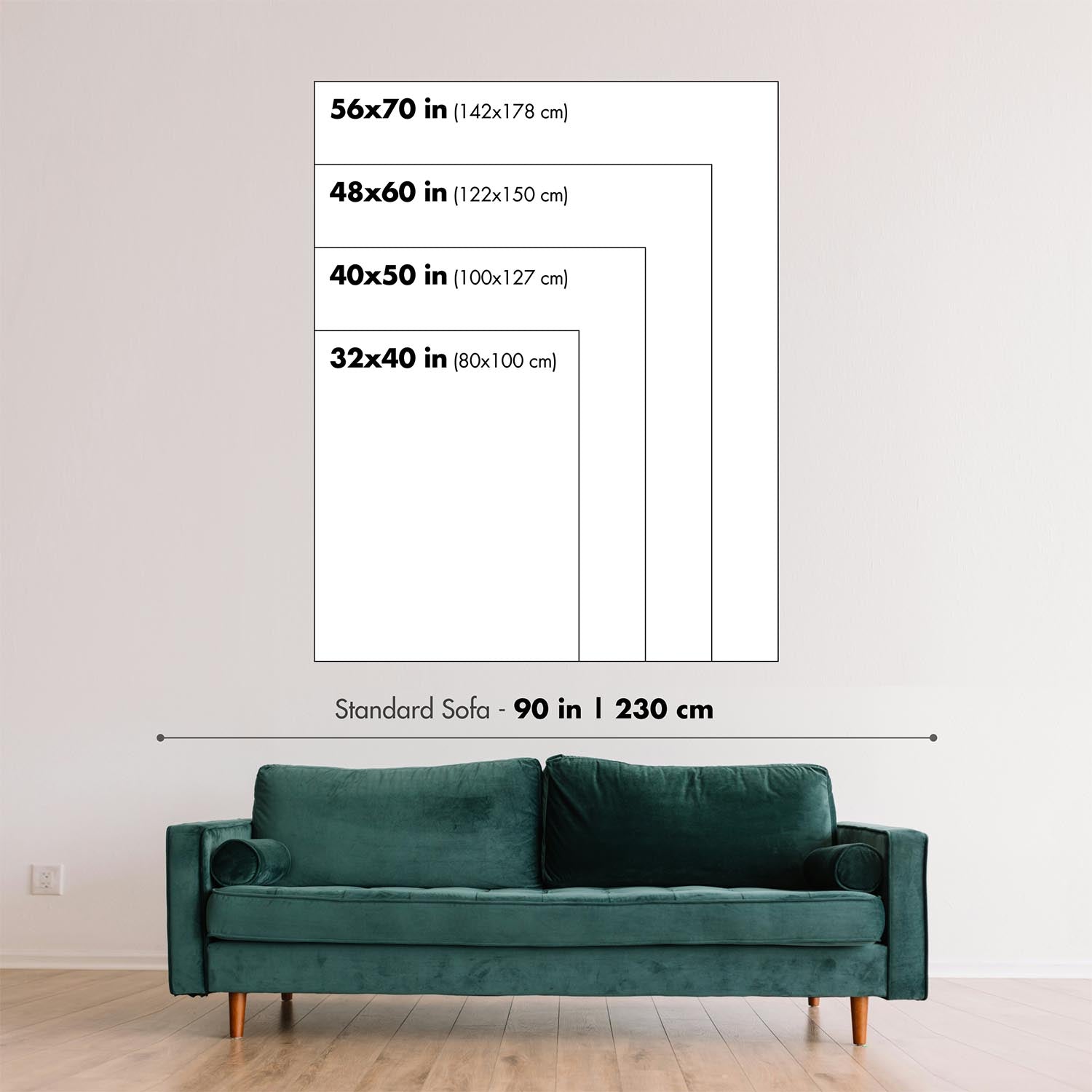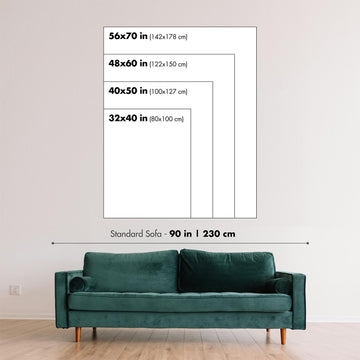- Handmade locally. No import duty or tax
- FREE Delivery by Christmas
- Love it or your money back (90 days)
- Questions? WhatsApp me any time
Own a piece of history
5,000+ 5 star reviews


Embark on a vivid journey through the heart of East Africa with the "East Africa" map, a masterful creation by the renowned Scottish cartographer John McKenzie. Crafted in 1961, this map is not merely a navigational tool but a vibrant tableau that captures the essence of Uganda, Kenya, and Tanganyika (now Tanzania). McKenzie, who spent many years in East Africa, utilized his profound understanding of the region to depict not only the geographical layout but also the rich tapestry of its wildlife and cultures. His work coincides with a pivotal era when these nations were on the cusp of independence, striving to forge a new identity free from colonial rule.
The map itself is a colorful, pictorial representation that goes beyond topographical accuracy to include enchanting illustrations of Africa's iconic fauna such as elephants, lions, giraffes, and zebras. These illustrations are not just decorative but serve as a gateway to understanding the diverse ecosystems that characterize the region. Additionally, the map highlights major cities like Nairobi, Dar es Salaam, and Mombasa, intricately marked with major roads that connect these bustling hubs of culture and commerce. The inclusion of political borders and natural features like lakes, rivers, and mountain ranges provides a comprehensive view of the landscape's physical and administrative dimensions.
John McKenzie's map also serves as a cultural archive, showcasing various local tribes including the Maasai, Kikuyu, and Luo, each represented in vibrant scenes and traditional attire. These depictions are thoughtfully placed alongside illustrations of safari camps, encapsulating the adventurous spirit of East Africa's tourism, which was burgeoning at the time. This feature not only adds to the map's aesthetic appeal but also offers insights into the social fabric and lifestyles of the region's inhabitants during a transformative period in their history.
Noteworthy are the detailed insets of Tsavo and Serengeti National Parks, which are renowned for their wildlife and ecological significance. These insets allow for a closer look at areas that are key to understanding East Africa's environmental conservation efforts and the challenges they face. The shaded relief and spot elevations provide a sense of the terrain, enhancing the map's utility for both educational and recreational purposes.
In conclusion, John McKenzie's "East Africa" map is a treasure trove of information and beauty, reflecting the geographical, political, and cultural landscapes of a region at a historical crossroads. It is not only a tool for navigation but also a piece of art that tells the story of East Africa's rich heritage and its journey towards independence. This map is an invaluable resource for historians, educators, and anyone fascinated by the allure of East Africa.
Cities and towns on this map
- Kenya
- Nairobi: 4,397,073
- Mombasa: 1,208,333
- Kisumu: 610,996
- Nakuru: 564,241
- Eldoret: 475,716
- Meru: 396,143
- Thika: 384,232
- Nyeri: 295,150
- Kitale: 284,196
- Malindi: 281,810
- Garissa: 256,088
- Kakamega: 248,261
- Machakos: 246,077
- Kisii: 244,899
- Kericho: 237,220
- Naivasha: 236,688
- Lamu: 235,162
- Kilifi: 233,404
- Bungoma: 229,679
- Busia: 226,342
- Homa Bay: 222,614
- Migori: 219,556
- Narok: 218,803
- Embu: 213,126
- Marsabit: 199,011
- Mandera: 184,714
- Wajir: 179,930
- Isiolo: 175,616
- Nanyuki: 171,724
- Mumias: 157,264
- Murang'a: 156,337
- Maralal: 154,741
- Siaya: 152,336
- Voi: 151,613
- Taveta: 148,760
- Malaba: 145,956
- Lodwar: 143,810
- Kapenguria: 141,531
- Mwingi: 140,992
- Witu: 136,985
- Lamu island: 135,836
- Nyahururu: 135,080
- Mwatate: 133,936
- Wundanyi: 132,326
- Hola: 128,846
- Thika Town: 128,479
- Naro Moru: 127,467
- Migori: 126,204
- Mbale: 124,888
- Elwak: 124,398
- Moyale: 123,932
- Wajir: 123,224
- Archer's Post: 122,848
- Takaba: 122,768
- Kilifi Creek: 122,505
- Kiambu: 122,192
- Mpeketoni: 121,602
- Bura: 121,378
- Madogo: 120,922
- Kalokol: 120,783
- Kolbio: 120,615
-
Kiunga: 120,320
-
Tanzania
- Dar es Salaam: 4,364,541
- Mwanza: 1,287,042
- Arusha: 416,442
- Mbeya: 385,279
- Tanga: 273,332
- Dodoma: 208,243
- Morogoro: 207,296
- Tabora: 199,924
- Kigoma: 197,421
- Moshi: 184,292
- Iringa: 151,347
- Songea: 146,066
- Shinyanga: 145,000
Notable Features & Landmarks
- Pictorial illustrations of local wildlife
- Shaded relief
- Spot elevations
- Political borders
- Major rivers
- Major lakes
- Mountain ranges
- National parks and game reserves
- Inset map of Tsavo National Park
- Inset map of Serengeti National Park
Historical and design context
- Title: East Africa
- Mapmaker/Publisher: John McKenzie; East African Standard Ltd., Nairobi
- Date: 1961
- Design or style: Colourful, pictorial
- Historical significance or context: The map was created at a time when East Africa was undergoing significant political and social change, reflecting the region's journey towards independence and a growing sense of national identity.
Please double check the images to make sure that a specific town or place is shown on this map. You can also get in touch and ask us to check the map for you.
This map looks great at every size, but I always recommend going for a larger size if you have space. That way you can easily make out all of the details.
This map looks amazing at sizes all the way up to 90in (230cm). If you are looking for a larger map, please get in touch.
The model in the listing images is holding the 16x20in (40x50cm) version of this map.
The fifth listing image shows an example of my map personalisation service.
If you’re looking for something slightly different, check out my collection of the best old maps to see if something else catches your eye.
Please contact me to check if a certain location, landmark or feature is shown on this map.
This would make a wonderful birthday, Christmas, Father's Day, work leaving, anniversary or housewarming gift for someone from the areas covered by this map.
This map is available as a giclée print on acid free archival matte paper, or you can buy it framed. The frame is a nice, simple black frame that suits most aesthetics. Please get in touch if you'd like a different frame colour or material. My frames are glazed with super-clear museum-grade acrylic (perspex/acrylite), which is significantly less reflective than glass, safer, and will always arrive in perfect condition.
This map is also available as a float framed canvas, sometimes known as a shadow gap framed canvas or canvas floater. The map is printed on artist's cotton canvas and then stretched over a handmade box frame. We then "float" the canvas inside a wooden frame, which is available in a range of colours (black, dark brown, oak, antique gold and white). This is a wonderful way to present a map without glazing in front. See some examples of float framed canvas maps and explore the differences between my different finishes.
For something truly unique, this map is also available in "Unique 3D", our trademarked process that dramatically transforms the map so that it has a wonderful sense of depth. We combine the original map with detailed topography and elevation data, so that mountains and the terrain really "pop". For more info and examples of 3D maps, check my Unique 3D page.
For most orders, delivery time is about 3 working days. Personalised and customised products take longer, as I have to do the personalisation and send it to you for approval, which usually takes 1 or 2 days.
Please note that very large framed orders usually take longer to make and deliver.
If you need your order to arrive by a certain date, please contact me before you order so that we can find the best way of making sure you get your order in time.
I print and frame maps and artwork in 23 countries around the world. This means your order will be made locally, which cuts down on delivery time and ensures that it won't be damaged during delivery. You'll never pay customs or import duty, and we'll put less CO2 into the air.
All of my maps and art prints are well packaged and sent in a rugged tube if unframed, or surrounded by foam if framed.
I try to send out all orders within 1 or 2 days of receiving your order, though some products (like face masks, mugs and tote bags) can take longer to make.
If you select Express Delivery at checkout your order we will prioritise your order and send it out by 1-day courier (Fedex, DHL, UPS, Parcelforce).
Next Day delivery is also available in some countries (US, UK, Singapore, UAE) but please try to order early in the day so that we can get it sent out on time.
My standard frame is a gallery style black ash hardwood frame. It is simple and quite modern looking. My standard frame is around 20mm (0.8in) wide.
I use super-clear acrylic (perspex/acrylite) for the frame glass. It's lighter and safer than glass - and it looks better, as the reflectivity is lower.
Six standard frame colours are available for free (black, dark brown, dark grey, oak, white and antique gold). Custom framing and mounting/matting is available if you're looking for something else.
Most maps, art and illustrations are also available as a framed canvas. We use matte (not shiny) cotton canvas, stretch it over a sustainably sourced box wood frame, and then 'float' the piece within a wood frame. The end result is quite beautiful, and there's no glazing to get in the way.
All frames are provided "ready to hang", with either a string or brackets on the back. Very large frames will have heavy duty hanging plates and/or a mounting baton. If you have any questions, please get in touch.
See some examples of my framed maps and framed canvas maps.
Alternatively, I can also supply old maps and artwork on canvas, foam board, cotton rag and other materials.
If you want to frame your map or artwork yourself, please read my size guide first.
My maps are extremely high quality reproductions of original maps.
I source original, rare maps from libraries, auction houses and private collections around the world, restore them at my London workshop, and then use specialist giclée inks and printers to create beautiful maps that look even better than the original.
My maps are printed on acid-free archival matte (not glossy) paper that feels very high quality and almost like card. In technical terms the paper weight/thickness is 10mil/200gsm. It's perfect for framing.
I print with Epson ultrachrome giclée UV fade resistant pigment inks - some of the best inks you can find.
I can also make maps on canvas, cotton rag and other exotic materials.
Learn more about The Unique Maps Co.
Map personalisation
If you're looking for the perfect anniversary or housewarming gift, I can personalise your map to make it truly unique. For example, I can add a short message, or highlight an important location, or add your family's coat of arms.
The options are almost infinite. Please see my map personalisation page for some wonderful examples of what's possible.
To order a personalised map, select "personalise your map" before adding it to your basket.
Get in touch if you're looking for more complex customisations and personalisations.
Map ageing
I have been asked hundreds of times over the years by customers if they could buy a map that looks even older.
Well, now you can, by selecting Aged before you add a map to your basket.
All the product photos you see on this page show the map in its Original form. This is what the map looks like today.
If you select Aged, I will age your map by hand, using a special and unique process developed through years of studying old maps, talking to researchers to understand the chemistry of aging paper, and of course... lots of practice!
If you're unsure, stick to the Original colour of the map. If you want something a bit darker and older looking, go for Aged.
If you are not happy with your order for any reason, contact me and I'll get it fixed ASAP, free of charge. Please see my returns and refund policy for more information.
I am very confident you will like your restored map or art print. I have been doing this since 1984. I'm a 5-star Etsy seller. I have sold tens of thousands of maps and art prints and have over 5,000 real 5-star reviews. My work has been featured in interior design magazines, on the BBC, and on the walls of dozens of 5-star hotels.
I use a unique process to restore maps and artwork that is massively time consuming and labour intensive. Hunting down the original maps and illustrations can take months. I use state of the art and eye-wateringly expensive technology to scan and restore them. As a result, I guarantee my maps and art prints are a cut above the rest. I stand by my products and will always make sure you're 100% happy with what you receive.
Almost all of my maps and art prints look amazing at large sizes (200cm, 6.5ft+) and I can frame and deliver them to you as well, via special oversized courier. Contact me to discuss your specific needs.
Or try searching for something!















































